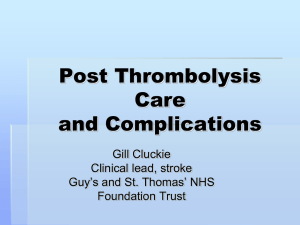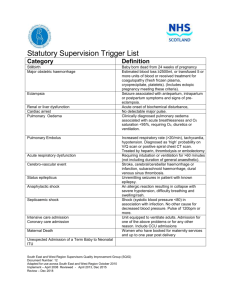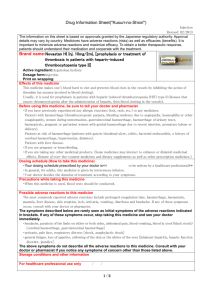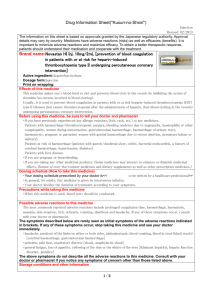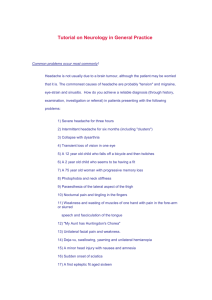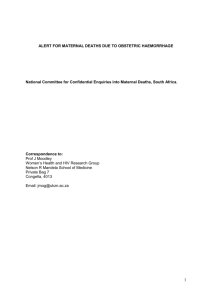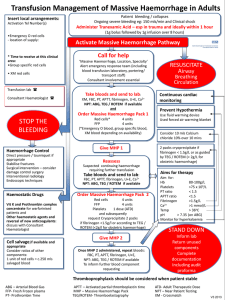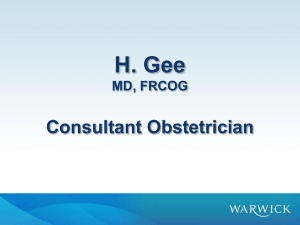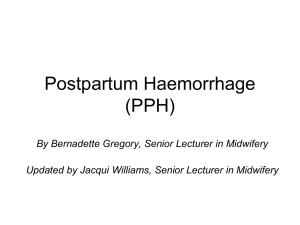Document 14240151
advertisement
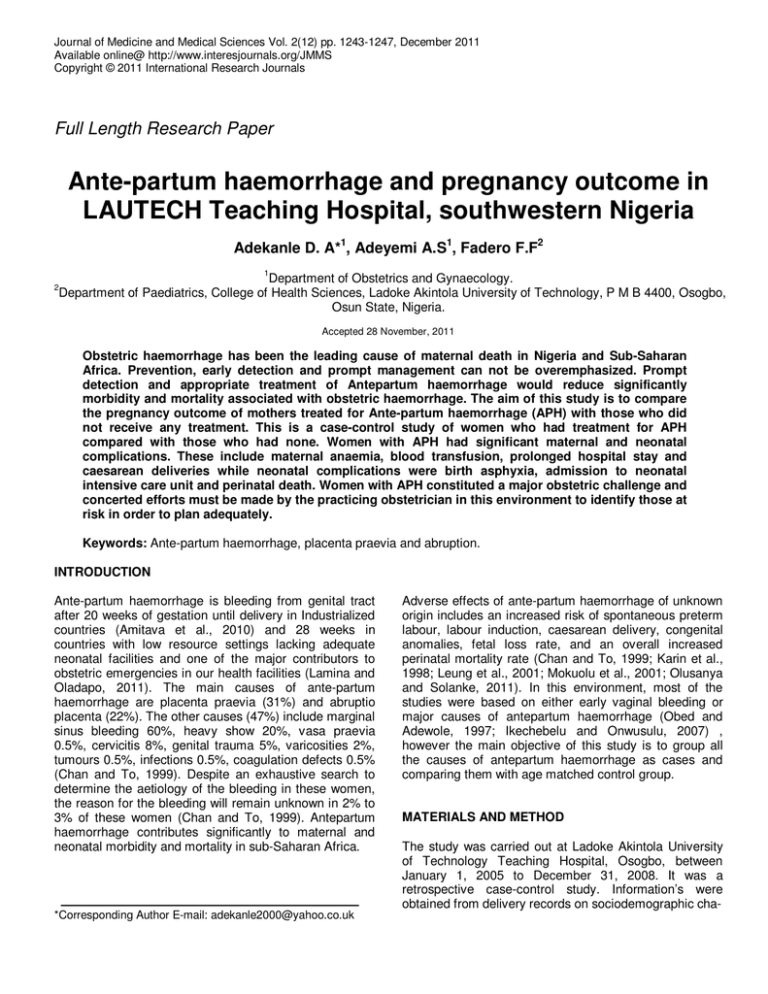
Journal of Medicine and Medical Sciences Vol. 2(12) pp. 1243-1247, December 2011 Available online@ http://www.interesjournals.org/JMMS Copyright © 2011 International Research Journals Full Length Research Paper Ante-partum haemorrhage and pregnancy outcome in LAUTECH Teaching Hospital, southwestern Nigeria Adekanle D. A*1, Adeyemi A.S1, Fadero F.F2 1 Department of Obstetrics and Gynaecology. Department of Paediatrics, College of Health Sciences, Ladoke Akintola University of Technology, P M B 4400, Osogbo, Osun State, Nigeria. 2 Accepted 28 November, 2011 Obstetric haemorrhage has been the leading cause of maternal death in Nigeria and Sub-Saharan Africa. Prevention, early detection and prompt management can not be overemphasized. Prompt detection and appropriate treatment of Antepartum haemorrhage would reduce significantly morbidity and mortality associated with obstetric haemorrhage. The aim of this study is to compare the pregnancy outcome of mothers treated for Ante-partum haemorrhage (APH) with those who did not receive any treatment. This is a case-control study of women who had treatment for APH compared with those who had none. Women with APH had significant maternal and neonatal complications. These include maternal anaemia, blood transfusion, prolonged hospital stay and caesarean deliveries while neonatal complications were birth asphyxia, admission to neonatal intensive care unit and perinatal death. Women with APH constituted a major obstetric challenge and concerted efforts must be made by the practicing obstetrician in this environment to identify those at risk in order to plan adequately. Keywords: Ante-partum haemorrhage, placenta praevia and abruption. INTRODUCTION Ante-partum haemorrhage is bleeding from genital tract after 20 weeks of gestation until delivery in Industrialized countries (Amitava et al., 2010) and 28 weeks in countries with low resource settings lacking adequate neonatal facilities and one of the major contributors to obstetric emergencies in our health facilities (Lamina and Oladapo, 2011). The main causes of ante-partum haemorrhage are placenta praevia (31%) and abruptio placenta (22%). The other causes (47%) include marginal sinus bleeding 60%, heavy show 20%, vasa praevia 0.5%, cervicitis 8%, genital trauma 5%, varicosities 2%, tumours 0.5%, infections 0.5%, coagulation defects 0.5% (Chan and To, 1999). Despite an exhaustive search to determine the aetiology of the bleeding in these women, the reason for the bleeding will remain unknown in 2% to 3% of these women (Chan and To, 1999). Antepartum haemorrhage contributes significantly to maternal and neonatal morbidity and mortality in sub-Saharan Africa. *Corresponding Author E-mail: adekanle2000@yahoo.co.uk Adverse effects of ante-partum haemorrhage of unknown origin includes an increased risk of spontaneous preterm labour, labour induction, caesarean delivery, congenital anomalies, fetal loss rate, and an overall increased perinatal mortality rate (Chan and To, 1999; Karin et al., 1998; Leung et al., 2001; Mokuolu et al., 2001; Olusanya and Solanke, 2011). In this environment, most of the studies were based on either early vaginal bleeding or major causes of antepartum haemorrhage (Obed and Adewole, 1997; Ikechebelu and Onwusulu, 2007) , however the main objective of this study is to group all the causes of antepartum haemorrhage as cases and comparing them with age matched control group. MATERIALS AND METHOD The study was carried out at Ladoke Akintola University of Technology Teaching Hospital, Osogbo, between January 1, 2005 to December 31, 2008. It was a retrospective case-control study. Information’s were obtained from delivery records on sociodemographic cha- 1244 J. Med. Med. Sci. Table 1. Socio-demographic characteristics Variable Age(years) ≤ 24 25 – 29 30 – 34 ≥35 Tribe Yoruba Ibo Marital Status Married Single Parity Nullipara Para 1 – 4 Para ≥ 5 Booking Status Booked Unbooked Previous Abortion Nill Had Abortions Mode of delivery Spontaneous Vaginal Delivery Caesarean Section racteristics of women presenting at gestational age of 28 weeks and above with antepartum haemorrhage and corresponding age-matched group. Others include causes of bleeding, maternal and neonatal complications. Categorical variables were summarized using numbers and percentages while mean and standard deviation for normally distributed continuous variables and MannWhitney U test for skewed variables. Measure of association was carried out using student-t test and chisquare where appropriate. Binary logistic regression was done to assess the risk factors to Ante-partum Haemorrhage. Level of significance was put at less than 5%. RESULTS There were 2,358 deliveries in the study period. The study was age-matched, 36 cases were retrieved for analysis and 77 in the control group. There was no mean age and parity difference between the cases and control; 30.5±6.8 years, 29.2±5.2years p > 0.05 and 1.9±1.4, 1.5±1.3 p > 0.05. Majority of the parturients, 45 (39.8%) were in age between 25 and 29 years and were mostly Yoruba ethnic tribe, 110 (97.3%) (Table 1). They were mainly Para 1 – 4, Number Percentage 17 45 29 22 15.0 39.8 25.7 19.5 110 3 97.3 2.7 111 2 98.2 1.8 28 81 4 24.8 71.7 3.5 56 57 49.6 50.4 67 46 59.3 40.7 53 60 46.9 53.1 81(71.7%), 56 (49.6%) were booked and most of them 60 (53.1%) had caesarean deliveries. Major cause of Antepartum Haemorrhage (APH) was placenta praevia 20(55.6%), abruption placentae were 12 (33.3%) and 3 (8.4%) were of unknown cause (Table 2). Eight (7.1%) of the women had postpartum haemorrhage, 14 (12.4%) were transfused. Twenty eight (24.8%) babies were admitted to intensive care baby unit while 13 (11.5%) had early neonatal death. Pre-delivery packed cell volume was significantly lower in cases than the control group; ( 27.7±5.0 Vs 30.9±5.2; p < 0.01 ) (Table 3). More women 9(25.0%) in cases were transfused than those in the control group 5(6.5%); Fisher’s Exact < 0.05. Higher proportion of women in the cases had caesarean deliveries compared to the control group (63.9% Vs 39.0%, p < 0.05). Duration of post delivery hospital stay was significantly higher among the cases than the control (72.4 Vs 49.8; p < 0.001). Mean apgar score both at 1 minute and 5 minutes were significantly higher in the control group compared to the cases (4.9 Vs 6.2, p < 0.001; 7.0 Vs 8.8 p < 0.01 respectively). However, incidence of birth asphyxia was only significantly higher at 5 minutes among the cases compared to the control (38.9% Vs 8.3% p < 0.01). The mean birth weight was significantly lower in the Adekanle et al. 1245 Table 2. Comparative analysis between cases and control Variable AGE(YEARS) PARITY Pre-delivery PCV Post-delivery PCV Booking Status Booked Unbooked Blood Transfusion Yes No Mode of Delivery Caesarean Section SVD Hospital Stay (days) Neonatal Status Apgar Score at 1 minute Apgar Score at 5minutes Apgar Score at 1min Apgar Score ≤ 6 Apgar Score ≥ 7 Apgar Score at 5mins Apgar Score ≤ 6 Apgar Score ≥ 7 Birth weight(kg) Baby’s birth weight < 2.5kg ≥ 2.5kg Admission to NICU Yes No Alive Dead Cases N = 36 30.5±6.8 1.9±1.4 27.7±5.0 27.5±5.7 Control N = 77 29.2±5.2 1.5±1.3 30.9±5.3 29.5±5.4 Test Statistic 12(33.3%) 24(66.7%) 44(57.1%) 33(42.9%) χ = 5.56 9(25.0%) 27(75.03%) 5(6.5%) 72(93.5%) Fisher’s Exact 23(63.9%) 13(36.1%) 72.4 30(39.0%) 47(61.0%) 49.8 χ = 6.12 M-W U 4.9±2.7 7.0±3.4 6.2±1.7 8.8±1.5 t = 4.04 t = 3.90 22(61.1%) 14(38.9%) 30(41.7%) 42(58.3%) χ = 3.64 1 > 0.05 14(38.9%) 32(61.1%) 2.6±0.7 6(8.3%) 66(91.7%) 3.2±1.4 χ2 = 14.85 t = 2.16 1 < 0.001 < 0.05 9(25.0%) 27(75.0%) 9(12.3%) 64(87.7%) χ2 = 2.81 1 > 0.05 12(33.3%) 24(66.7%) 28(78.8%) 8(22.2%) 16(20.8%) 21(79.2%) 72(93.5%) 5(6.5%) χ2 = 2.07 1 > 0.05 t t t t df = 1.12 = 1.43 = 3.06 = 1.83 2 2 2 Fisher’s Exact P Value > 0.05 > 0.05 < 0.01 > 0.05 1 < 0.05 < 0.05 1 < 0.05 < 0.01 < 0.001 < 0.01 < 0.05 t = Student-t test M-W U = Mann-Whitney U test df = degree of freedom PCV = packed cell volume NICU = Neonatal intensive care unit SVD = Spontaneous Vertex Delivery cases than the control (2.6kg Vs 3.2kg p < 0.05) but there no significant difference in the incidence of low birth weight (p > 0.05). Perinatal mortality was significantly higher among the cases compared to the control group (22.2% Vs 6.5% Fisher’s Exact < 0.005). After adjusting for age, previous abortions, parity and packed cell volume at presentation, unbooked paturients were significantly more likely to present with antepartum haemorrhage (OR=2.443, 95% CL 1.030 – 5.794). DISCUSSION The incidence of ante-partum haemorrhage was 1.5% which was slightly lower than those of developed settings 2-5% (Chan and To, 1999). The major cause of antepartum haemorrhage was found to be placenta praevia followed by abruption placenta and lastly by unknown causes in agreement with findings in other centres (Shih-Chen et al., 2003; Ikechebelu and Onwusulu, 2007). Extremes of iron status during preg- 1246 J. Med. Med. Sci. Table 3. Logistic regression analysis on factors associated with antepartum haemorrhage VARIABLE Age Booking Status Unbooked / Booked (ref) Abortion Yes / No (ref) Parity Packed Cell Volume(PCV) < 30% / ≥ 30%(ref) β 0.025 S.E 0.043 WALD 0.331 P Value 0.565 OR 1.025 95% CI 0.942 – 1.115 0.893 0.441 4.112 0.043 2.443 1.030 – 5.794 0.336 0.102 0.425 0.184 0.623 0.310 0.430 0.578 1.399 1.108 0.608 – 3.220 0.773 – 1.589 0.333 0.433 0.589 0.443 1.395 0.596 – 3.260 S.E = Standard error OR = Odd Ratio CI = Confidence interval nancy adversely affect pregnancy outcomes (Ziaei et al., 2008). Several studies have shown a relationship between haemoglobin levels above 13.2g/dl and below 10.4g/dl to be associated with adverse pregnancy outcomes such as stillbirths, pregnancy induced hypertension, intrauterine growth restriction, low birth weight, preterm delivery, perinatal death (Ziaei et al., 2008; Mokuolu et al., 2010). This study has shown higher prevalence of anaemia among the parturients with antepartum haemorrhage which also resulted from significant blood loss and increase transfusion rate in consonant with other studies (Faponle and Makinde, 2007) thus putting more pressure on already depleted blood banks even though functional blood banks are not readily available in our environment. Caesarean section is generally accepted as a safe alternative mode of delivery in developed countries by both patients and caregivers however there is strong aversion to the procedure by women in sub-Saharan Africa but ante-partum haemorrhage is one of major indications for caesarean section (Ojiyi et al., 2008; Swende, 2008 ). Even though safe it is not without important risks such as increased mean blood loss, febrile illness, thromboembolic disease , infection and a mortality risk of up to five times that of vaginal delivery (Griffiths, 2005; Ijaiya and Aboyeji, 2001). There are also fetal risks including lacerations and increased rate of respiratory disorders (Smith, 2004). There was significant higher proportion caesarean deliveries in the cases compared to the control which agrees with other studies (McCormack et al., 2008). Prolonged hospital admission increases cost and more psychological stress on the family especially the other siblings from prolonged absence of the mother. Our findings have shown significant prolonged hospital admission among the parturients with antepartum haemorrhage. Neonatal asphyxia has been associated with neonatal morbidity and mortality. Mean Apgar score was significantly lower among the cases, with higher proportion of birth asphyxia which corroborates other studies (Caroline, 1998). Birth weight is one of the determinants of neonatal survival, the mean birth weight was significantly lower among women with antepartum haemorrhage and also the incidence of low birth weight was higher, these are in support of other studies (McCormack et al., 2008; Olusanya and Ofovwe, 2010). Ante-partum haemorrhage has been implicated as a major cause of perinatal death(Onyiriuka, 2009; Oladapo et al., 2007). Perinatal mortality was significantly higher among the cases which is agreement with other studies in developed setting (Magann et al., 2005). Pregnancy outcome in our study among women with antepartum haemorrhage was associated with both maternal and neonatal complications. Management of this obstetric condition poses a serious challenge to the obstetrician and haemorrhage being a major cause of maternal mortality (Owolabi et al., 2008). Various treatment options have been suggested such cervical cerclage with other treatment methods for placenta praevia (Sinha and Kuruba, 2008) which was a major cause of antepartum haemorrhage in our study and immediate delivery is advocated for abruption due to insufficient man power and equipments for antepartum surveillance. There is need for continuous education and retraining of health care givers especially those involved in labour management on how to prevent ruptured uterus. After adjusting for other factors such as age, previous abortion, parity, and packed cell volume at presentation, booking status at presentation remains the major predictor of antepartum haemorrhage. Parturients that were not booked in our health facility were significantly at higher risk of having antepartum haemorrhage supporting similar reports in our environment (Owolabi et al., 2008 ), thus there is need for proper networking among the referring health facilities and where possible to communicate with our health facility before patient’s arrival to labour room. This will help in adequate prepara- Adekanle et al. 1247 tion for proper management especially in poor resource setting like ours where response to emergency is quite lower compared to advanced setting. CONCLUSION Ante-partum haemorrhage was found to be associated with poor maternal and neonatal outcome in this study and the major predictor was booking status. There is need to improve on infrastructures such as functional blood banks, quality of care and referral system in our health facilities to be able to cope with increasing challenges of this obstetric haemorrhage. REFERENCES Amitava RS, Saikat SR, Biswa jit N, Gaurab M, Jayanta M (2010). Management of obstetric haemorrhage. M.E. J. Anaesth 20 (4): 499-508 Caroline CS, Anil S, Douglas SR (1998). Second-trimester vaginal bleeding: Correlation of ultrasonographic findings with perinatal outcome Am. J. Obstet. Gynecol. 178:336-40. Chan CC, To WW (1999). Antepartum hemorrhage of unknown origin— what is the clinical significance. Acta. Obstet. Gynecol. Scand.78:186–190. Faponle AF, Makinde ON (2007). Caesarean section: intra-operative blood loss and its restitution. East Afr. Med. J. 84(1):31-4. Griffiths AN, Avasarala S, Wiener J (2005). A prospective observational study of emergency caesarean section rates and the effect of the labour ward experience. J. obste. and gynaecol. 25(7): 666 – 668 Ijaiya MA, Aboyeji PA (2001). Caesarean Delivery: The Trend over a Ten-Year Period at Ilorin, Nigeria. The Niger. J. Surg. Res. 3(1):11-18 Ikechebelu JI, Onwusulu DN (2007). Placenta praevia: review of clinical presentation and management in a Nigerian teaching hospital. Niger J Med. 16(1):61-64. Karin SA, Bakhtawar I, Butta AT, Jalil M (1998). Effects of first and second trimester vaginal bleeding on pregnancy outcome. J. Pak. Med. Assoc. 48:40–42. LaminaMA, Oladapo OT (2011). Maternal and Fetal Outcome of Obstetric Emergencies in a Tertiary Health Institution in SouthWestern Nigeria. Gynecology Obstetrics and Gynecology. Article ID 160932, 4 doi:10.5402/2011/160932 Leung TY, Chan LW, Tam WH, Lau TK (2001). Risk and prediction of preterm delivery in pregnancies complicated by antepartum hemorrhage of unknown origin before 34 weeks. Gynecol Obstet Invest. 52:227–231. Magann EF, Cummings JE, Niederhauser A, Rodriquez-Thompson D, McCormack R, Chauhan SP(2005). Antepartum Bleeding of Unknown Origin in the Second Half of Pregnancy: A Review Obstetrical and Gynecological Survey. l60, (11): 741-745 McCormack RA, Doherty DA, Magann EF, Hutchinson M, Newnham JP (2008). Antepartum bleeding of unknown origin in the second half of pregnancy and pregnancy outcomes. BJOG. 115(11):1451–1457. MokuoluOA, Suleiman BM, Adesiyun OO, Adeniyi A (2010). Prevalence and determinants of pre-term deliveries in the University of Ilorin Teaching Hospital, Ilorin, Nigeria. Pediatric Reports. 2. (e3):11-14 Obed JY, Adewole IF (1997). Antepartum haemorrhage: the influence of first trimester uterine bleeding. West Afr. J. Med. 16(1):24-26. Ojiyi EC, Dike EI, Idrissa AU (2008). Primary caeserean section in grandmultiparae at Mater Misericordiae Hosptal Afikpo: a 5 year retrospective study. Niger. J. Clin. Pract.11 (4):368-371. Oladapo OT, Adekanle DA, Durojaiye BO (2007). Maternal risk factors associated with fetal death during antenatal care in low-resource tertiary hospitals. Aus.t N Z J. Obstet. Gynaecol. 47(5):383-388. Olusanya BO, Solanke OA (2011). Maternal and neonatal profile of latepreterm survivors in a poorly resourced country. J. Matern. Fetal Neonatal. Med. 24 (Epub ahead of print). Olusanya BO, Ofovwe GE (2010). Predictors of preterm births and low birthweight in an inner-city hospital in sub-Saharan Africa. Matern. Child Health J. 14(6):978-986. Onyiriuka AN (2009). Analysis of stillbirths in a Nigerian mission hospital. Nig. Q J Hosp. Med. 19 (1):27-31. Owolabi AT, Fatusi AO, Kuti O, Adeyemi A, Faturoti SO, Obiajuwa PO (2008). Maternal complications and perinatal outcomes in booked and unbooked Nigerian mothers. Singapore Med. J. 49(7): 526-531. Shih-Chen Chang, Kimberly O, O’Brien, Nathanson MS, Mancini J, Witter FR (2003). Haemoglobin Concentrations Influence Birth Outcomes in Pregnant African-American Adolescents. J. Nutr. 133: 2348–2355. Sinha P, Kuruba N (2008). Ante-Partum Haemorrhage: An Update. J. Obste. and Gynaecol. 28(4): 377 – 381. Smith GC, Wood AM, White IR, Pell JP, Cameron AD, Dobbie R(2004). Neonatal respiratory morbidity at term and the risk of childhood asthma. Archives of Disease in Childhood. 89(10): 956 – 960. Swende TZ (2008). Emergency caesarean section in a Nigerian tertiary health centre. Niger. J. Med. 17(4):396-398. Ziaei S, Janghorban R, Shariatdoust S, Faghihzadeh S (2008). The effects of iron supplementation on serum copper and zinc levels in pregnant women with high-normal haemoglobin. Int. J. Gynecol. Obst. 100(2):133–135.
